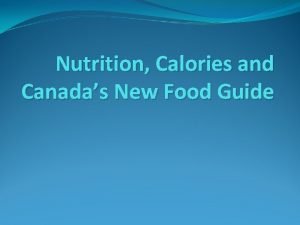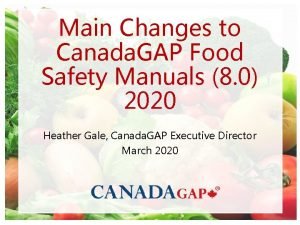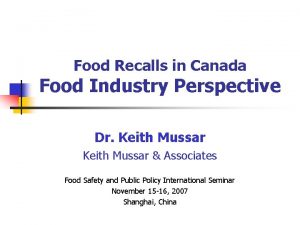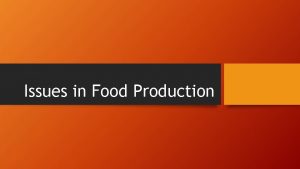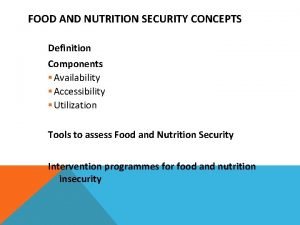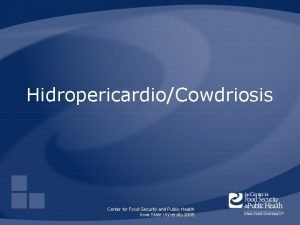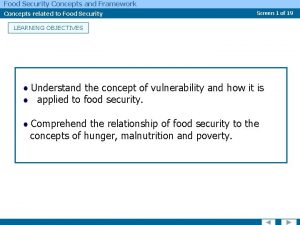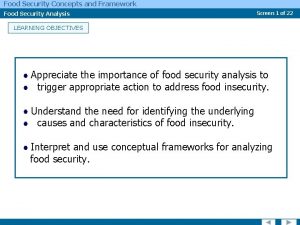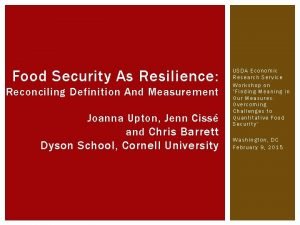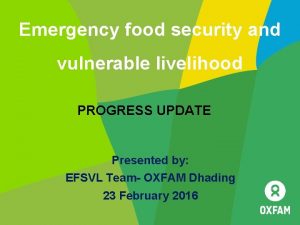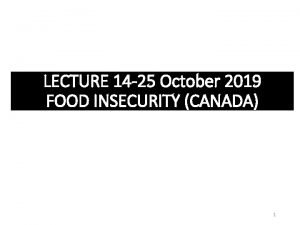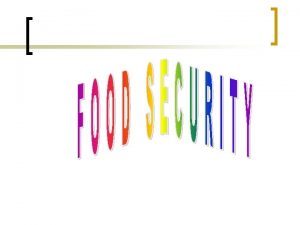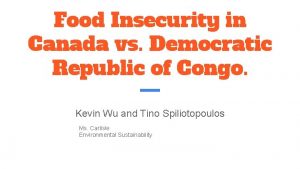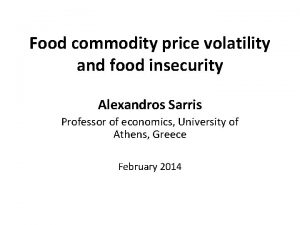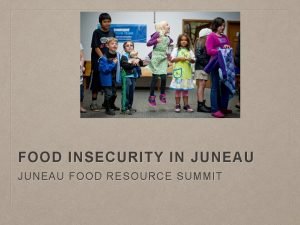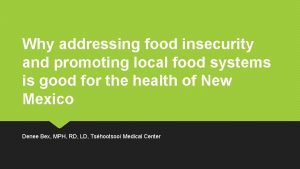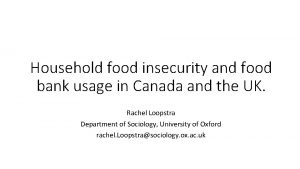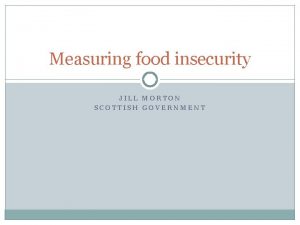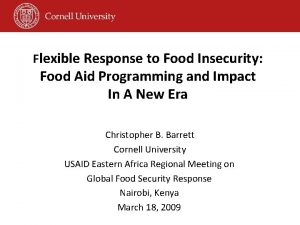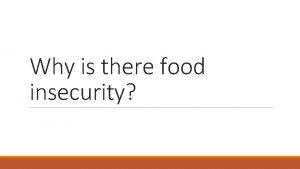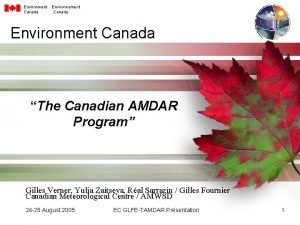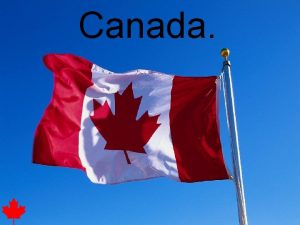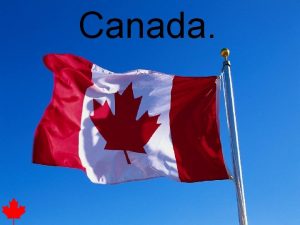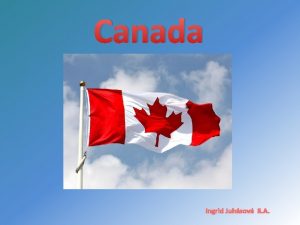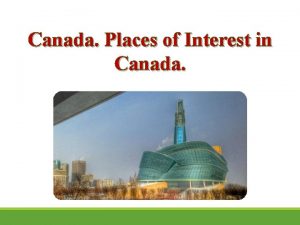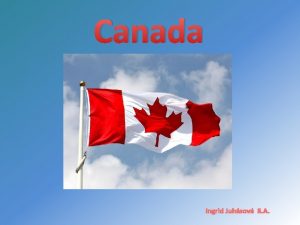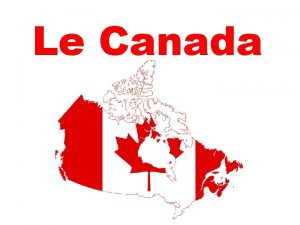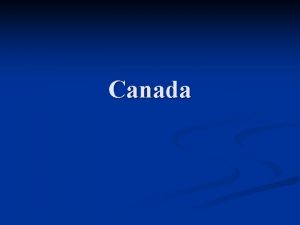LECTURE 13 FOOD INSECURITY CANADA 1 Food security





























































- Slides: 61

LECTURE 13 FOOD INSECURITY (CANADA) 1

“Food security exists when all people, at all times, have physical and economic access to sufficient, safe and nutritious food to meet their dietary needs and food preferences for an active and healthy life. ” GOV OF CANADA DIETITIANS OF CANADA In North America, food security has been defined as “a situation in which all community residents can obtain a safe, culturally acceptable, nutritionally adequate diet through a sustainable food system that maximizes self-reliance and social justice”. Violation of one or more aspects of either definition of food security means food insecurity. Thus, public health inspectors are very important at the processing level and at the level of food establishments (e. g. restaurants and pubs) in terms of ensuring food security. 2

Deconstructing household food insecurity: insights from Canadian research Valerie Tarasuk Professor, Department of Nutritional Sciences Faculty of Medicine, University of Toronto PROOF: V Tarasuk (PI, U Toronto), C Gundersen (co-PI, U Illinois), L Mc. Intyre (U Calgary), H Emery (U Calgary), C Mah (Memorial U), J Rehm (CAMH), P Kurdyak (CAMH), N Dachner (Coordinator, U Toronto). Acknowledgement: This research is funded by a programmatic grant from the Canadian Institutes of Health Research. 3

Outline: • Food banks: the public face of the problem • Food insecurity monitoring: a different perspective on the problem • Relation between food insecurity, nutrition and health. • Social policy underpinnings 4

Defining the problem: Household food insecurity: insecure or inadequate access to food due to financial constraints - popularly termed “hunger” 5

The evolution of food banks and food insecurity measurement: 1994: Measure of child hunger on National Longitudinal Survey of Children & Youth 2005: food insecurity monitoring begins Assorted indicator questions 1989: ‘Hunger. Count’. 1981: First food bank. 1980 1997: Annual release of ‘Hunger. Counts’. 1987: Canadian Association of Food Banks formed. 1990 2000 6

Household Food Security Survey Module (administered on the Canadian Community Health Survey since 2004) 18 questions, differentiating adults’ and children’s experiences over last 12 months: • • Worry about not having enough food Reliance on low-cost foods Not able to afford balanced meals Adults/children skip meals Adults/children cut size of meals Adults/children not having enough to eat Adult lost weight Adults/children not eating for whole day “because there wasn’t enough money to buy food? ” 7

Household Food Insecurity in Canada, 2007 - 2012 • 12. 6% of households • over 4 million Canadians (an increase of > 600, 000 since 2007) Marginal food insecurity Worry about running out of food and/or limit food selection because of lack of money for food. Moderate food insecurity Compromise in quality and/or quantity of food due to a lack of money for food. Severe food insecurity Miss meals, reduce food intake and at the most extreme go day(s) without food. Data Source: Statistics Canada, CCHS, 2007, 2008, 2011, 2012 and 2013. 8

Number of people living in food-insecure households in Canada, 2007 - 2012 4, 500, 000 4, 000 3, 398, 500 3, 422, 900 3, 874, 000 4, 005, 000 3, 500, 000 3, 000 2, 500, 000 2, 000 1, 500, 000 1, 000 500, 000 0 2007 2008 2011 2012 Data Sources: Statistics Canada, Canadian Community Health Survey (CCHS), 2007, 2008, 2011 and 2012, and Food 9 Banks Canada, Hunger. Count, 2007, 2008, 2011 and 2012.

Number of people living in food-insecure households vs number reported to be helped by food banks in March of respective year. 4, 500, 000 4, 000 3, 500, 000 3, 000 2, 500, 000 Food Insecure 2, 000 Food Bank Use 1, 500, 000 1, 000 500, 000 0 2007 2008 2011 2012 Data Sources: Statistics Canada, Canadian Community Health Survey (CCHS), 2007, 2008, 2011 and 2012, and Food 10 Banks Canada, Hunger. Count, 2007, 2008, 2011 and 2012.

Relationship between food insecurity and food bank use? • Most people affected by food insecurity do not seek charitable food assistance. disconnect between help offered and perceived needs of food insecure. arbitrary nature of charitable service provisioning renders it inaccessible to many. • Food bank users are a relatively small, non-representative subset of food insecure population. (Hamelin et al, Health Educ Res 2010; Loopstra & Tarasuk, Can Public Policy 2012; Loopstra & Tarasuk, Soc Pol Soc 2015) 11

National prevalence of household food insecurity and poverty (defined as income < Low-Income Measure), 2007, 2008, 2011, 2012. 16 14 12 10 % 8 LIM Food insecurity 6 4 2 0 2007 2008 2011 2012 LIM: 50% of median household income, adjusted for household size. Source: PROOF calculations from CCHS 2007 -08, 2011 -12 and Statistics Canada. CANSIM. Table 111 -0015 Family characteristics, Low Income Measures (LIM), by family type and family type composition. 12

Relationship between food insecurity and household income: Food insecurity captures material deprivation. the product of • income (size, security, stability) • assets / home ownership • access to credit • expenses (shelter, food, medications, debt, etc) 13 (Tarasuk, Mitchell & Dachner, Household Food Insecurity in Canada, 2014. 2016)

FOOD INSECURITY, FOOD AND HEALTH? 14

Results from CCHS 2004 - Nutrition Adults’ fruit and vegetable consumption, servings per day by food security status * * servings/day * * * Food secure Food insecure Age/sex group Food insecurity here includes only moderate and severe food insecurity. *Significant difference between food-secure & food-insecure subgroups, p<0. 05 (Kirkpatrick & Tarasuk, Journal of Nutrition, 2008: 138: 604 -612) 15

Results from CCHS 2004 - Nutrition Adults’ fruit and vegetable consumption, servings per day by food security status * * servings/day * * * Food secure Food insecure Recommended Age/sex group Food insecurity here includes only moderate and severe food insecurity. *Significant difference between food-secure & food-insecure subgroups, p<0. 05 16

Results from CCHS 2004 - Nutrition Children’s fruit and vegetable consumption, servings per day by food security status 9 8 7 6 servings/day 5 4 * * 3 Food secure Food insecure Recommended 2 1 0 1 -3 y 4 -8 y M 9 -13 y F 9 -13 y M 14 -18 y F 14 -18 y Age/sex group Food insecurity here includes only moderate and severe food insecurity. *Significant difference between food-secure & food-insecure subgroups, p<0. 05 17

Average SODIUM intake (mg/day), by age, sex and household food security status: a a a, b a: P < 0. 05, comparison of transformed intakes; b: P<0. 05, ANOVA adjusted for income, education, immigrant status, household composition, and current smoking. Food insecurity here includes only moderate and severe food insecurity. 18

Prevalence of nutrient inadequacy by food security status, individuals ≥ 9 years of age in Canada 70 % inadequate intakes 60 50 40 30 food secure 20 food insecure 10 ne s nc M ag Zi iu m m C al c iu te Fo la in ta m Vi Vi ta m in A C 0 Note: food insecure defined here as ≥ 3 affirmatives on 18 -item HFSSM. (Kirkpatrick et al, Journal of Nutrition, 2015) 19

The health effects of food insecurity: Summary of observed associations, all independent of income, education, race/ethnicity and other social determinants of health: Maternal and infant health • Poorer birth outcomes • Impaired growth and development Children • Poorer development and learning • Impeded disease management • Increased likelihood of developing asthma, depression, other chronic conditions. Adults • Compromised physical and mental health • Poor disease management and heightened odds of negative outcomes (including mortality). (See review by Gundersen & Ziliak, Health Affairs, 2015; 34: 1830 -1839) 20

Prevalence of chronic conditions among Canadian adults, (18 -64 years) of age, by household food insecurity status and sex Mood or anxiety disorder Severe food insecurity Hypertension Moderate food insecurity Heart Disease Women Marginal food insecurity Diabetes mellitus Food secure Severe food insecurity Bowel Disorders Back Problems Men Moderate food insecurity Marginal food insecurity Arthritis Food secure Asthma 0 10 20 30 % adults reporting condition 40 50 (Adapted from Tarasuk V, Mitchell A, Mc. Laren L, & Mc. Intyre L. Journal of Nutrition. 143(11), 1785 -93. ) 21

Average health care costs person incurred over 12 months for Ontario adults (18 -64 years of age), by household food insecurity status: $3930 4000 3500 $2806 3000 $ Prescription drugs 2500 Home care services $2161 Same day surgery 2000 Inpatient costs $1608 Physician services 1500 Emergency Other 1000 500 0 secure marginally insecure moderately insecure severely insecure (Tarasuk et al, Canadian Medical Association Journal, 2015) 22

POLICY INSIGHTS ARISING FROM ANALYSES OF MONITORING DATA 23

24 (Tarasuk, Mitchell & Dachner, Household Food Insecurity in Canada, 2014. 2016)

Prevalence of food insecurity by main source of income, 2014 70 60 50 40 % 30 20 Seniors have a Guaranteed Annual Income, indexed to inflation 10 0 Senior's incomes Employment severe Other/none moderate EI, Workers' Comp Social Assistance marginal 25 (Tarasuk, Mitchell & Dachner, Household Food Insecurity in Canada, 2014. 2016)

Probability of food insecurity by age for unattached, low-income adults (pooled data from the Canadian Community Health Survey, 2007 -2013). 0. 45 0. 40 0. 35 Fitted Probability 0. 30 0. 25 Fitted Probability Baseline Probability 0. 20 Avg post 65 prob 0. 15 0. 10 0. 05 0. 00 56 57 58 59 60 61 62 63 64 Age (years) 65 66 67 68 69 70 (Mc. Intyre, Dutton, Kwok & Emery, Canadian Public Policy 2016) 26

Probability of food insecurity by age for unattached, low-income adults (pooled data from the Canadian Community Health Survey, 2007 -2013). 0. 45 0. 40 0. 35 Fitted Probability 0. 30 0. 25 Fitted Probability Baseline Probability 0. 20 Avg post 65 prob 0. 15 0. 10 0. 05 0. 00 56 57 58 59 60 61 62 63 64 Age (years) 65 66 67 68 69 70 (Mc. Intyre, Dutton, Kwok & Emery, Canadian Public Policy 2016) 27

Prevalence of food insecurity by main source of income, 2014 Low benefit levels + asset limits + restrictions on earnings = extreme vulnerability. 70 60 50 40 % 30 20 10 0 Senior's incomes Employment severe Other/none moderate EI, Workers' Comp Social Assistance marginal 28 (Tarasuk, Mitchell & Dachner, Household Food Insecurity in Canada, 2014. 2016)

Prevalence of food insecurity among households in Newfoundland Labrador reporting any income from social assistance. 70% 59. 9% 60% 59. 2% 57. 4% 50% 44. 8% 44. 0% 40% 33. 5% 30% 20% Provincial actions to reduce poverty 10% 0% 2007 2008 2009 2010 2011 2012 29 (Loopstra, Dachner & Tarasuk, Canadian Public Policy, September, 2015)

Summary • Systematic measurement of food insecurity in Canada has revealed a very different problem than the one apparent from food bank utilization statistics. • Food insecurity is related to dietary intake, but its effects on health go well beyond nutrition. • Household food insecurity is a potent determinant of health and health care spending in Canada. • This problem is rooted in financial constraints and appears very sensitive to social policy decisions. • http: //proof. utoronto. ca/food-insecurity/ 30

Feeding My Family Raising Awareness about the high cost of food in The North! C "It's about people coming together and doing something you were raised up to believe…. . . my parents taught me that we have to work together to make sure everyone gets enough to eat. ”

Vast Area – Few People • 2 million square kilometres (same size as Western Europe) • 25 communities - accessible by air and sea only • Population of Nunavut = 31, 906 1 • Population of Pangnirtung = 1506 1 1. Statistics Canada, 2011 Census of Population feedingmyfamily. org

Income - vs - Cost of Food • In 2009, the median total income for Nunavut was $26, 830/year 1 • The current average cost to feed a family of 4 in Nunavut is $437. 00/week or $22, 724/year 2 1. Second lowest in the country. Statistics Canada, Income Statistics Division, Special Tabulations (Prepared by: Nunavut Bureau of Statistics, November 7, 2011) 2. Nutrition North Canada; Department of Aboriginal Affairs and Northern Development Canada (Note – does not include High Arctic communities of Grise Fiord and Resolute) feedingmyfamily. org

Definition of Poverty Statistics Canada defines a low -income household as one which spends a much higher proportion of its income on the necessities of life − food, shelter and clothing − than does an average equivalent household. A low-income household is defined as one which spends more than about 55% on necessities. ” With current high food prices, many Northerners would have to spend more than 100% of their incomes in order to feed their families properly. Statistics Canada does not collect or compile data directly measuring poverty in Nunavut. feedingmyfamily. org

We can’t eat just like our ancestors did • Inuit traditional practices are still strong and hunting for sustenance remains an important part of life • Poverty is preventing many people from living entirely off the land • Start-up costs are very high: Snowmobile ($10, 000), gas ($400 per trip), kamotik made of wood ($1000), GPS ($200) and satellite phone ($1000), gun and bullets. ($1000) • Even if you are able to harvest wildlife, it is shared among extended family members • Traditional Foods harvested from the land now supplement store-bought foods in the North feedingmyfamily. org

Extreme Environment • We have extreme cold conditions, limited sunlight, high electricity costs, permafrost, and blindingly high construction and maintenance costs. • Many of the usual fixes for food insecurity like agriculture and greenhouses are not possible. Kugaa ruk, N unavu t in Feb ruary feedingmyfamily. org

Nunavut Sealink & Supply Inc Transportation by Sea • All communities receive an annual resupply by ship • Most economical shipping method; mainly limited to non-perishable items • Most people not in an economic position to buy a year’s worth of canned & dry goods at one time • Inuit value system encourages sharing of resources, resulting in bulk food purchases consumed quickly by those in need. feedingmyfamily. org

Transportation by Air • Most communities also receive daily air service for passengers and perishable foods. • Air freight charges and passenger fares are very expensive compared to the rest of Canada – even short distances. • Over $3, 000 for round trip travel from Pangnirtung to Edmonton. feedingmyfamily. org

Government Food Subsidy Programs Country Food Distribution Program • Started in 2012 by Government of Nunavut • Funding to help Nunavummiut meet basic food needs by increasing access to country foods • Open to community Hunters & Trappers Organizations, registered societies, municipalities, and Co-operatives • Eligible projects - community freezers, paying hunters to stock community freezers, meet processing equipment and training, and help establishing country food markets feedingmyfamily. org

Government Food Subsidy Programs Nutrition North Canada (NNC) • Started in 2011 by Government of Canada (Aboriginal Affairs and Northern Development Canada) • Food freight subsidy program that replaced former Food Mail Program • Intent is to provide Northerners with healthy food choices at affordable prices • Freight subsidy provided directly to retailers with expectation that savings will be passed on to their customers feedingmyfamily. org

Why Not Move? ? ? This is home Costs of moving Arctic Sovereignty feedingmyfamily. org

Feeding My Family The beginning of a movement

Our Group’s Intentions: 1. To raise awareness about high cost of food in Nunavut 2. To organize peaceful protests in communities 3. To provide a forum where Nunavummiut could come together to talk about struggles with high cost of food and the affects that hunger has on their lives 4. To unite Northerners’ voices as one feedingmyfamily. org

Photos of actual food prices 1. TO RAISE AWARENES S Price comparisons feedingmyfamily. org

In Communities across Nunavut In Ottawa 2. TO ORGANIZE PROTESTS feedingmyfamily. org

Protesting brings awareness, but goes against tradition “Protesting is not something Inuit traditionally do. Inuit are taught not cause disruption to others. In the past, this was one of the main consensus: everyone needed to work together to survive in the harsh environment. ” feedingmyfamily. org

Brainstorming community-based solutions Sharing stories of personal struggles Questioning the effectiveness of Government programs & policy 3. TO PROVIDE A DISCUSSION FORUM FOR NUNAVUMMIUT Organizing spin-off groups to offer immediate help to hungry people Food for Nunavut Group, Nunavut Adopt-a-Family feedingmyfamily. org

4. TO UNITE ALL NORTHERN VOICES AS ONE – WITH ONE STRONG MESSAGE feedingmyfamily. org

High cost of freight and airfare Limited variety of foods in the stores High cost of doing business in the North Poor Quality Produce and Meats Overcrowded Households Hard to plan ahead to buy cheaper food from the South when you’re living day-to-day feedingmyfamily. org

Many foods being sold years past their best before dates and the other extreme… Stores throwing away food that is still edible feedingmyfamily. org

What members said about NNC: Nutrition North Canada (NNC) is not working well for Northerners …it subsidizes Retailers, not Northerners. …there’s no way to know how much of the savings are being passed on to us. …we have no choice but to shop from expensive stores in our communities because very few southern retailers participate in the program. …the airlines now treat food as general cargo and there are no quality control measures to ensure that food is transported properly. …the only Northerners who can truly benefit from NNC are the few who can still order from southern retailers. feedingmyfamily. org

Nutrition North Canada (NNC) is not working well for Northerners are concerned about recent changes in program objectives on the NNC website: In 2010 – “The Government of Canada is committed to providing Northerners with healthy food choices at affordable prices. ” Current – “The Government of Canada is committed to helping Canadians make healthy food choices. ” www. nunatsiaqonline. ca October 21, 2012 advertisement feedingmyfamily. org

There is an immediate need for Food Banks in Northern Communities What members said about food banks: …setting up and operating food banks is difficult in smaller communities. …it’s hard to find a proper and available location for a food bank. …there aren’t enough community members willing to volunteer to operate a food bank. feedingmyfamily. org

Feeding My Family Turning thoughts into action

Our Group’s Current Objectives: 1. Encourage Northerners to empower themselves to create independence from within the people at the grass roots level. 2. Unify people across the North to share one voice. 3. Encourage Government policy-makers and retailers to find better ways to lower the cost of food (NNC is not doing enough). 4. Encourage new food suppliers to operate in the North in order to increase competition and lower prices. 5. Encourage improvements in food quality through better inventory control, such as: • Removing inedible and rotting food from store shelves • Proper food shipping and handling • Reducing transit time for perishable foods 6. Encourage establishment of more Food Banks. 7. Work with Government and other NGOs to improve the overall quality of life for Northerners. feedingmyfamily. org

“Inuit have long lived to survive – it is in our blood to find food and help others when someone goes hungry. Inuit all over the north have understood the word “hunger” from the past to this day. It is handled through patience, through acceptance, and through innovations. Hunger was fought by our ancestors, and we can fight it again today using different techniques. ” Northerners are coming together as one to have ONE VOICE. Qujanamiik - Thank You

Food insecurity is an urgent public health issue for Aboriginal people in Canada because of high rates of poverty; the effects of global climate change and environmental pollution on traditional food systems; and high rates of diet-related diseases. However, to date, public health has operated with conceptualizations of food security that were developed in non-Aboriginal contexts; they do not take full account of the traditional food practices of Aboriginal people or Aboriginal conceptualizations of food security. Northerners are coming together as one to have ONE VOICE. Qujanamiik - Thank You

NNC and food insecurity https: //www. cbc. ca/news/canada/no rth/food-insecurity-nunavut-nutrition -north-1. 5140132 Recent Changes to NNC https: //www. cbc. ca/news/canada/no rth/nutrition-north-reaction 1. 5258341 58

NNC and food insecurity “Food insecurity was a pervasive problem in Nunavut before Nutrition North Canada, but it has become even more prevalent since the program was implemented. Given the important health consequences of food insecurity, more effective initiatives to address food insecurity in Canada’s North are urgently needed. ” Fafard St-Germain et al 2019. Canadian Medical Association Journal 191: E 552 E 558 https: //www. cmaj. ca/content/cmaj/19 1/20/E 552. full. pdf 59

List everything you know of that can cause foodborne illness How does food borne illness have to do with food security? 60

Healthy Eating- some Canadian physicians American Academy of Pediatrics Says Some Common Food Additives May Pose Health Risks to Children Inside the fight to label sugary, salty and fatty foods in Canada Food companies' marketing of junk food and a potential government response Food guidance A high fat diet is best C. difficile and trehalose Warning about melamine in supplements TRANS FATS BAN IN CANADA 17 SEPTEMBER 2018 61
 Private secuirty
Private secuirty 01:640:244 lecture notes - lecture 15: plat, idah, farad
01:640:244 lecture notes - lecture 15: plat, idah, farad Computer security 161 cryptocurrency lecture
Computer security 161 cryptocurrency lecture Food safety food security
Food safety food security Canada's old food guide
Canada's old food guide Canada gap manual
Canada gap manual Food recalls canada
Food recalls canada Osi security architecture model with neat diagram
Osi security architecture model with neat diagram Security guide to network security fundamentals
Security guide to network security fundamentals Wireless security in cryptography
Wireless security in cryptography Visa international security model
Visa international security model Electronic mail security in network security
Electronic mail security in network security Cnss security model
Cnss security model Security policy and integrated security in e-commerce
Security policy and integrated security in e-commerce Software security touchpoints
Software security touchpoints Security guide to network security fundamentals
Security guide to network security fundamentals Security guide to network security fundamentals
Security guide to network security fundamentals Unit 2 food food food
Unit 2 food food food Sequence of food chain
Sequence of food chain Factors that affect food security
Factors that affect food security Define nutrition security
Define nutrition security The center for food security & public health
The center for food security & public health Food security concepts and frameworks
Food security concepts and frameworks Food security conceptual framework
Food security conceptual framework Food security tep
Food security tep Define global food security
Define global food security Emergency food security and vulnerable livelihoods
Emergency food security and vulnerable livelihoods Project procurement management lecture notes
Project procurement management lecture notes Lecture about sport
Lecture about sport Healthy lifestyle wrap up lecture
Healthy lifestyle wrap up lecture Nihilism vs existentialism
Nihilism vs existentialism Life lecture meaning
Life lecture meaning Randy pausch the last lecture summary
Randy pausch the last lecture summary Tensorflow lecture
Tensorflow lecture Theology proper lecture notes
Theology proper lecture notes Strategic management lecture
Strategic management lecture Geology lecture series
Geology lecture series Social psychology lecture
Social psychology lecture In text citation for a lecture
In text citation for a lecture Public sector accounting lecture notes pdf
Public sector accounting lecture notes pdf Project planning begins with the melding of
Project planning begins with the melding of Practical design to eurocode 2
Practical design to eurocode 2 Magnetism
Magnetism Classical mechanics
Classical mechanics Physics 101 lecture
Physics 101 lecture Physical science lecture notes
Physical science lecture notes Power system dynamics and stability lecture notes
Power system dynamics and stability lecture notes Natural language processing nlp - theory lecture
Natural language processing nlp - theory lecture Microbial physiology lecture notes
Microbial physiology lecture notes Sensors and actuators lecture notes
Sensors and actuators lecture notes Ternology
Ternology Les types de lecture au primaire
Les types de lecture au primaire Instruction de lecture
Instruction de lecture Aronautique
Aronautique Lecture title
Lecture title Lecture presentations for campbell biology
Lecture presentations for campbell biology Financial engineering notes
Financial engineering notes Bipolar junction transistor notes
Bipolar junction transistor notes Requirement analysis in software engineering notes
Requirement analysis in software engineering notes Extension lecture meaning
Extension lecture meaning Le registre dominant dans le dernier jour d'un condamné
Le registre dominant dans le dernier jour d'un condamné Tegrity lecture capture
Tegrity lecture capture




